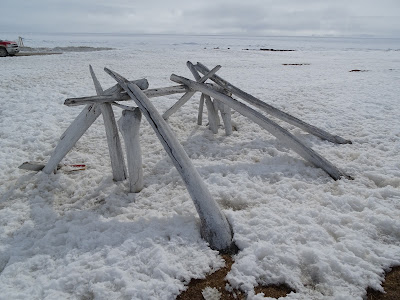 |
| Raven metal sculpture in Iqaluit on a clear blue-sky day |
 |
| Mountains and glaciers of Bylot Island from Pond Inlet |
On Sunday we organised all the food and equipment we need
to take into the field. We had placed some large food orders that were air
freighted to Resolute earlier this year. The weight limit for our Twin Otter
flight into Alexandra Fiord is a little less than normal as we will be flying
in on skis and landing out on the sea ice. We also want to minimise the number
of heavy items we need to carry 1/2km from the sea ice to our camp. We are just
waiting for some glass gas sample vials for plant nitrification testing to arrive on special order from the UK
and the weather to cooperate and then we will fly to Alexandra Fiord.
 |
| Twin Otter plane with skis to land on the sea ice at
Alexandra Fiord. Our equipment and food ready to be loaded on to the Twin Otter (inset) |
In the afternoon we drove into the Hamlet of Resolute Bay. Around the
hamlet we saw five polar bear hides hanging out to dry. I have seen seal skins
stretched out on wooden frames to dry before in Iqaluit and Resolute but this
is the first time I have seen polar bear hides and five of them at that!
Hopefully these are the only bears I see this summer.
 |
| Polar bear hide (and a muskox hide on the railing!) hanging out to dry at Resolute Bay |
We also stopped at the Thule settlement opposite the rubbish dump. Most
of the site is still under snow but where the ground was bare I found new green
leaves of chickweed (Stellaria humifusa)
and poppy (Papaver sp.) just coming
out. In Iqaluit I saw new blades of grass and new fireweed (Chamerion latifolium) leaves. I expect I
will be recording leaf out dates of plants at Alexandra Fiord soon after we get
there.
 |
| Whale bones of an ancient Thule house near Resolute Bay. Skins would have been stretched over the whale bones to form the roof of the sunken dwelling currently hidden by snow. |
 |
| Herring gull scavenging at the Resolute Bay rubbish dump |
A group of researchers from Texas currently at PCSP are working
to determine the reasons for the existence of a 23km2 lake 400m underneath
the Devon Icecap. Aerial radar and gravity surveys of the icecap are being conducted
using a DC3 plane. The researchers think the lake water is saturated in salts
from the surrounding salt rich rocks and hence there is water, not ice, under
the icecap. On the tarmac the plane rests at a 12° angle which apparently makes
installing equipment quite a challenge, any screw dropped just rolls away!

Pleased you are now able to blog again. Interesting to read this blog & I did chuckle about your screws rolling away! Hope you all & glass vials get to Alex soon.
ReplyDelete